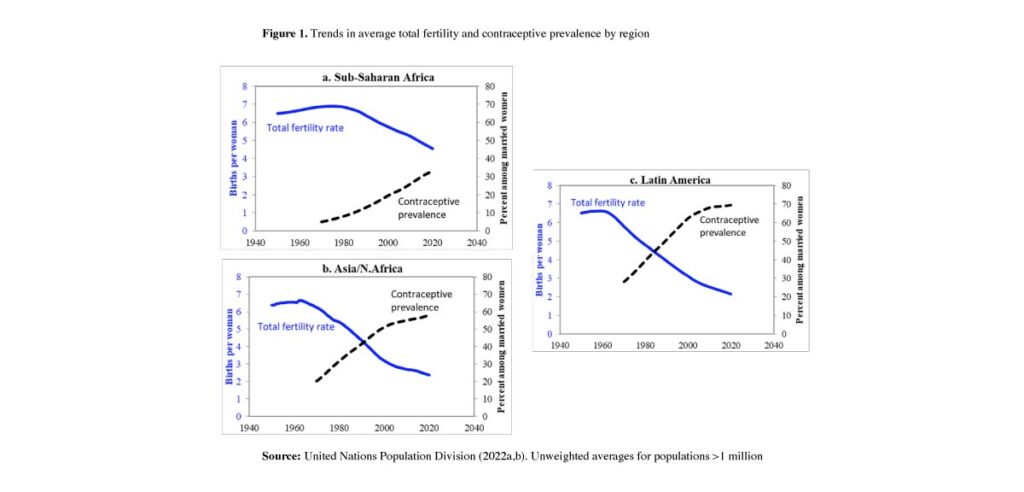Fertility transitions in low- and middle-income countries are driven by changes in both preferences for smaller families and their implementation. Claims of an overwhelming dominance of either changing demand or changing implementation, John Bongaarts maintains, are based on flawed methods and hence must be rejected.
Since the mid-twentieth century, the Global South has experienced unprecedently rapid and pervasive changes in reproductive behavior. In the 1950s fertility was high and contraceptive use was rare, with women typically bearing 6 to 7 children over a lifetime. Today, fertility has declined to below 3 births per woman in most countries in Asia, North Africa and Latin America and transitions in sub-Saharan Africa are underway (Figure 1). As expected, contraceptive use is very low during the pretransition period and rises as the transition progresses.

A large existing literature describes and analyzes the causes of these fertility declines. Over time a rough consensus has been reached on major questions about the socio-economic determinants of fertility, with rising female education and declining child mortality now considered essential for transitions to occur (Bongaarts and Hodgson 2022). However, there is one important unresolved controversy; it concerns the widely held view that changing reproductive preferences (i.e., declining desired family size and rising demand for contraception) are the dominant intervening factors through which socio-economic change brings about the fertility decline.
A continuing controversy
On one side of the controversy are analysts who accept the conventional demographic and economic assumption that reproductive change is driven largely by a decline in the desired family size. As traditional societies develop, the cost of children rises (e.g., for schooling) and their economic value (e.g., for labor and old-age security) declines and parents want children of greater “quality”. These trends in turn reduce desired family size and increase the demand for and adoption of birth control to implement changing reproductive preferences and to avoid unplanned pregnancies. This perspective is well summarized by Pritchett’s (1994) analysis of fertility in low-and middle-income countries (LMICs): “nearly all … of the differences between countries in actual fertility are accounted for solely by differences in desired fertility” (p. 2) and “the challenge of reducing fertility is the challenge of reducing people’s fertility desires, not reducing “unwanted” fertility” (p. 3). This side more or less takes for granted that women are able to implement their preferences by practicing effective birth control.
An opposing view has arisen from research on the relative roles of demand for contraception and the implementation/satisfaction of this demand as determinants of trends in contraceptive use. Several studies question Pritchett’s conclusion and suggest instead that the rising implementation of already existing demand is the main cause of the birth control revolution in the developing world. For example, a study of trends in contraceptive behavior by Ibitoye, Casterline, and Zhang (2022), concludes that their findings represent “a powerful empirical refutation of the view that contraceptive change has been driven principally by reductions in demand for children” (p. 361) and “to what extent can the substantial increases in contraception in recent decades in LMICs be attributed to more demand versus increased satisfaction of demand? Our results answer this question decisively and overwhelmingly against more demand: less than 10 percent of the [prevalence of modern contraception] change can be attributed to change in fertility preferences (and about 15 percent in a more elaborate decomposition …)” (p. 373).
These two studies come to opposing conclusions about the role of demand, with Pritchett claiming demand for children is the true driver of the fertility transition, while according to Ibitoye, Casterline, and Zhang (2022), the implementation of this demand is the main cause of the transition. The two sides in the debate will be referred to as the “demand perspective” and the “implementation perspective” respectively.
Why findings differ
In an analysis of the causes of the controversy, I find problems with the empirical analyses of both sides in the debate (Bongaarts 2024).
• Demand perspective: A key problem with Pritchett’s analysis is that its inferences about trends were drawn from cross-sectional data which often lead to biased findings. Studies of longitudinal data by Bongaarts and Hodgson (2023), Casterline et al. (2009), and Lam (2011) have assessed Pritchett’s claim about the relative roles of actual trends in wanted and unwanted fertility. They give a different result and assign a less dominant role to wanted fertility. Their findings range from 74% to 53% for the proportion of overall observed fertility decline that is due to declines in wanted fertility, thus indicating a substantially smaller role for demand than Pritchett claims.
• Implementation perspective: There are two biases in the studies of trends in contraceptive behavior. First, measurement of demand for contraception is based on survey questions about whether women want more children rather than about their desired family size. The problem with this question was identified by Lightbourne and McDonald (1982): “International comparisons of proportions wanting no more children can be somewhat misleading, since two populations with identical desired family size distributions could have substantially different proportions wanting no more children, if in one population women bear children less quickly or later in life as a consequence of such causes as later marriage or longer breastfeeding or more use of contraception for child spacing purposes, thereby producing a lower proportion wanting to stop with no real difference in underlying preferences”(p. 21).
In other words, when age at marriage and birth intervals rise over time, as they usually do, a substantial decline in wanted fertility can be accompanied by little change in the proportion wanting no more children, thus resulting in downward bias in estimates of the role of demand. A second problem with the studies of contraceptive trends is that they assume that demand and implementation components are not causally related. If, instead, the level of implementation of preferences is itself a function of the level of preferences, then the role of preferences will be underestimated. This is the argument made by Pritchett (1994) who considers the implementation of preferences to be endogenous, i.e. demand induces implementation. To reduce unwanted fertility, women need to take action to avoid getting pregnant after reaching their desired family size. This effort becomes increasingly difficult as wanted fertility declines because the number of years at risk of having an unwanted birth rises. For example, if a woman has reached her desired family size by age 25 then she can potentially have a half dozen more children before reaching menopause if no birth control is practiced. This outcome is of course highly undesirable, and women will make a strong effort to avoid it. The greater the risk of unwanted births, the greater this effort must be. In other words, declining wanted fertility appears to induce a contraceptive response that is sufficient to keep unwanted fertility from reaching high levels. This endogeneity implies that studies that assume independence between demand and implementation underestimate the role of preferences.
Conclusion
Given the methodological weaknesses in the cross-sectional studies of fertility and in studies of trends in demand for contraception, I conclude that the longitudinal studies of trends in wanted and unwanted fertility are the least problematic. However, these studies assume complete endogeneity of implementation which is probably not entirely realistic. Their estimates of the role of demand may therefore be slightly high.
The main conclusion from this exercise is that fertility transitions are driven by changes in both preferences and their implementation. Claims of an overwhelming dominance of either demand or implementation are based on flawed methods and hence must be rejected.
References
Bongaarts, John. 2024. “Fertility Transitions in Low- and Middle-Income Countries: The Role of Preferences”. In special issue, Looking Backward, Looking Forward: Celebrating 50 Years of Population and Development Review. Population and Development Review. Published online http://doi.org/10.1111/padr.12675
Bongaarts, John and Hodgson, Dennis. 2023. Fertility Transition in the Developing World. Springer.
Casterline, John, Mohammad Nizamuddin, Zeba A. Sathar and Iqbal Alam. 2009. “Demographic transition and unwanted fertility: A fresh assessment.” Pakistan Development Review 48(4): 387-421.
Ibitoye, Mobolaji, John Casterline and Chenyao Zhang. 2022. “Fertility preferences and contraceptive change in Low- and Middle-Income Countries.” Studies in Family Planning 53(2):361-376.
Lam, David. 2011. “How the world survived the population bomb: Lessons from 50 years of extraordinary demographic history.” Demography 48:1231-1262.
Lightbourne, Robert and Alphonse MacDonald. 1982. Family Size Preferences. Comparative Studies, Cross National Summaries No. 14. World Fertility Survey, London.
Pritchett, Lant. 1994. “Desired fertility and the impact of population policies.” Population and Development Review 20(1):1-55.
United Nations Population Division. 2022a. World Population Prospects 2022, Online Edition.
United Nations, Population Division. 2022b. World Contraceptive Use 2022. New York: United Nations.


